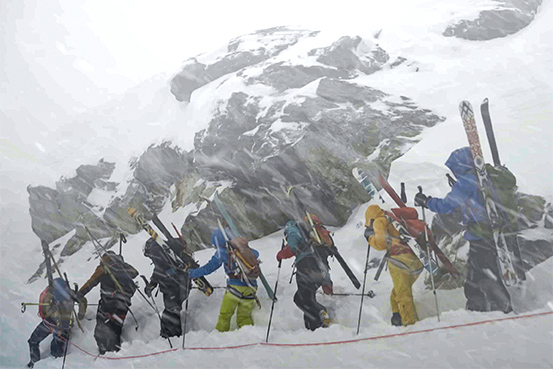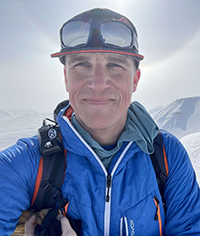Todesfalle Haute Route: Documentary Film Review

Was it bad luck? Human error? Recklessness?
Fatal accidents in the mountains generate many difficult questions. The recently released film Todesfalle Haute Route (Death Trap Haute Route) asks - and ends with - those three questions of the events of April 29th, 2018, when seven out of a ski touring group of ten people - including their guide - died of exposure in a storm, only 550 meters from the safety of a Swiss mountain hut.
The drama under the Pigne d'Arolla, on the legendary Haute Route, the ski tour between Chamonix and Zermatt, is the biggest disaster of its kind in the Swiss Alps. Was it an accident, human error? Frank Senn's film unpacks the drama and shows how it came about. Using the survivors' statements, documents and photos, re-enacted scenes, as well as excerpts from the investigation report of the Sitten public prosecutor's office, the dramatic events of this tour can be reconstructed and answers found. For the first time, the three survivors, rescuers, as well as Steve House, the famous mountaineer from America, and two couples from France, who were all traveling on the same route on the same day, talk about the drama. What happened on the tour is recounted in detail in reenactments. The film also shows that despite the supposed safety of modern tools and equipment, helicopter rescue and the proximity to civilization, nature is stronger than humans. It shows an example of what is happening in the Alps, where mountain tourism is becoming ever stronger and larger. What can be learned from this misfortune, are there consequences that need to be drawn from it?
Translated from the producer-created description of the film (available on YouTube). Although the audio is in German, YouTube subtitles allow for auto-translation into English (or any one of a wide variety of languages).
Was it bad luck? Human error? Recklessness?
I watched the documentary last night and reflected on those three questions - posed by a narrator at the end of the film. The surviving participants give some indication of their individual perspectives - but the film director offers viewers a compassionately nuanced, non-judgmental approach to this tragedy.
I watched and tried to learn, tried to understand. I thought of what I might have done if I were in the guide’s position. But mostly I felt deep sadness. My sorrow was for the survivors - for those who were there on that night and for the community of family and friends that were left behind to try to make sense of these events. Those who were left alive to carry the loss.
Risk - including the ultimate risk of death - is an aspect of mountain sports that has few parallels with other leisure activities. Unfortunately, making sense of tragedy and trauma in the mountains is something that many backcountry skiers must do during their engagement with the sport.
I wish this were not true. But it is.
The mountains have inherent risk. We accept the possibility of profound loss in the process of pursuing an activity that brings so much joy. It is a difficult reality to reconcile. Especially when people die in the mountains.
Towards the end of the film one of the survivors, an Italian man, recounts a conversation that he had with his psychologist after the event: “He [the psychologist] told me, ‘You should be over it now.’”
I was startled by this statement and I couldn’t disagree more.
Mountain accidents are traumatic. In my experience and observation, we may carry these events with us for the rest of our lives. I am thankful though, for the example of organizations like Mountain Muskox, Responder Alliance, and the American Alpine Club who demonstrate that individuals do not need to carry the weight of grief alone. In the aftermath of traumatic events we can lean on and learn from both mental health professionals and our peers.
Todesfalle Haute Route confronts the viewer with the challenge of making sense of tragedy and trauma in the mountains. It is a difficult challenge - one that hits close to home for backcountry skiers.
To watch in English, turn on Closed Captioning. Then, select Settings > Subtitles > Auto-Translate > English.
Jerry Isaak is an Associate Teaching Professor and the program lead for ski touring in the Adventure Studies Department at Thompson Rivers University in Kamloops, British Columbia. He is an AMGA certified Ski Guide and has guided backcountry ski adventures in Iceland, Kyrgyzstan, Japan, and throughout the United States and western Canada.










